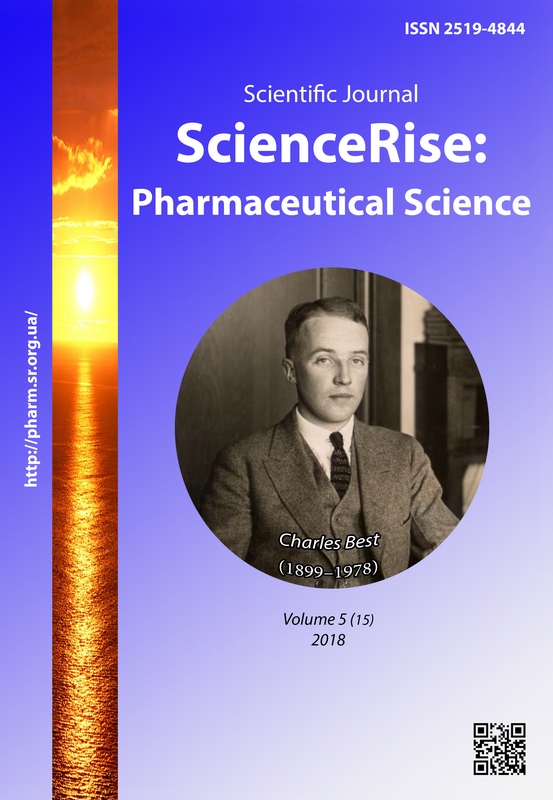Physico-chemical and pharmaco-technological research at a substantiation of rational composition and technology of suppositories «indoxam»
DOI:
https://doi.org/10.15587/2519-4852.2018.146500Keywords:
rectal suppositories "Indoxam", indole-3-carbinol, meloxicam, physico-chemical and pharmaco-technological research, composition, technologyAbstract
The development of new highly effective drugs in the form of rectal suppositories for the treatment of diseases of the prostate gland does not lose its relevance today, since the number of patients with these pathologies is increasing every year. These diseases adversely affect the physical, psychological health and quality of life of men in general.
An important issue in the substantiation of the composition and development of the technology for the production of suppositories is the study of their physico-chemical and pharmaco-technological properties that directly affect their consumer qualities and the mode of the technological process.
Aim of the work was the study of the physico-chemical and pharmaco-technological properties of the combined rectal suppositories "Indoxam" to select rational conditions of the technological process.
Materials and methods. In order to substantiate the composition and technology of the combined rectal suppositories “Indoxam”, modern physicochemical (thermal analysis, rotational viscometry method) and pharmaco-technological (disintegration suppositories, resistance to degradation) studies were used according to the requirements of SPHU.
Results. To select the optimal ratio of polyethylene oxides in the suppository base, the resistance of suppositories to destruction and the disintegration time of samples made with different amounts of PEO-1500 and PEO-400 were studied. To determine the optimal technology for the preparation of the drug, a study was made of the decomposition temperature of the API, which makes it possible to determine the temperature regimes for the preparation of suppositories and the introduction of active substances into the base without the risk of destroying the structure of substances and changing their pharmacological actions. Since, under the influence of mechanical, thermal, and other actions, several types of destruction undergo suppositories, their rheological characteristics are also investigated.
Conclusions. The results of pharmaco-technological research allowed to substantiate the optimal ratio of polyethylene oxides in suppository basis. The conducted thermogravimetric analysis of API and suppositories «Indoxam» established the thermal stability of substances and the absence of chemical interaction between the components in the composition of rectal drug. According to the rheological characteristics, the system identified the thixotropy and the optimal pouring temperature of the suppository mass
References
- Nieschlag, E., Behre, H. M., Nieschlag, S. (Eds.) (2010). Andrology: Male Reproductive Health and Dysfunction. Springer, 629. Available at: http://file.zums.ac.ir/ebook/042-Andrology%20-%20Male%20Reproductive%20Health%20and%20Dysfunction,%203rd%20ed.-Eberhard%20Nieschlag%20Hermann%20M.%20B.pdf
- Hadiak, I. V., Hromovyk, B. P. (2017). Asortymentna kharakterystyka prostatoprotektoriv, zareiestrovanykh v Ukraini, Respublitsi Polshcha ta Respublitsi Bilorus. Farmatsevtychnyi chasopys, 3, 77–85. Available at: http://tests.ifnmu.edu.ua:8080/library/DocDescription?doc_id=152085
- Havaldar, V. D., Yadav, A. V., Dias, R. J., Mali, K. K., Ghorpade, V. S., Salunkhe, N. H. (2015). Rectal suppository as an effective alternative for oral administration. Research Journal of Pharmacy and Technology, 8 (6), 759–766. doi: http://doi.org/10.5958/0974-360x.2015.00122.5
- Zaychenko, V. S., Ruban, O. A., Masliy, J. S., Gerbina, N. A. (2017). Justification of surface-active substances choice in composition of suppositories for treatment of prostate gland benign diseases. Ukrainian biopharmaceutical journal, 6 (53), 4–8. doi: http://doi.org/10.24959/ubphj.17.143
- Gritsenko, V. I. (2012). Razrabotka tekhnologii i termogravimetricheskiy analiz suppozitoriev s tamsulozinom dlya lecheniya giperplazii predstatel'noy zhelezy. Farmatsiya, 22 (141), 184–188. Available at: http://dspace.bsu.edu.ru/bitstream/123456789/17801/1/Gritsenko_Razrabotka.pdf
- Dmytriievskyi, D. I., Kobets, M. M., Kobets, Yu. M., Akhmedov, E. Yu., Kharkova, Yu. O. (2012). Marketynhovi doslidzhennia preparativ prostatoprotektoriv, predstavlenykh na farmatsevtychnomu rynku Ukrainy. Visnyk farmatsii, 3 (71), 28–31. Available at: http://dspace.nuph.edu.ua/bitstream/123456789/2194/1/28-31.pdf
- Patil, B. S., Mahajan, H. S., Surana, S. J. (2015). Development of Suppositories Containing Flutamide-Loaded Alginate-Tamarind Microparticles for Rectal Administration: In Vitro and in Vivo Studies. Chemical & Pharmaceutical Bulletin, 63 (11), 851–857. doi: http://doi.org/10.1248/cpb.c15-00250
- Pagano, E., Laudato, M., Griffo, M., Capasso, R. (2013). Phytotherapy of Benign Prostatic Hyperplasia. A Minireview. Phytotherapy Research, 28 (7), 949–955. doi: http://doi.org/10.1002/ptr.5084
- Zaychenko, G. V., Gorchakova, N. A., Sinitsina, O. S., Zaychenko, V. S., Ravshanov, T. B. (2018). Pharmacodynamics and indole-3-carbinol spectrum of action. Bulletin of Problems Biology and Medicine, 3 (145), 30–38. doi: http://doi.org/10.29254/2077-4214-2018-3-145-30-38
- Bradlow, H. L. (2008). Indole-3-carbinol as a chemoprotective agent in breast and prostate cancer. In vivo, 22 (4), 441–445. Available at: https://pdfs.semanticscholar.org/22fd/485e46ab699b1704a5f2d48a9aa4379fcbec.pdf
- Gorgel, S. N., Sefik, E., Kose, O., Olgunelma, V., Sahin, E. (2013). The Effect of Combined Therapy with Tamsulosin Hydrochloride and Meloxicam in Patients with Benign Prostatic Hyperplasia Symptoms and Impact on Nocturia and Sleep Quality. International Braz j Urol, 39 (5), 657–662. doi: http://doi.org/10.1590/s1677-5538.ibju.2013.05.07
- Bykovskiy, S. N. et. al. (Eds.) (2015). Farmatsevticheskaya razrabotka: kontseptsiya i prakticheskie rekomendatsii: nauchno-prakticheskoe rukovodstvo dlya farmatsevticheskoy otrasli. Moscow: Izd-vo Pero, 471. Available at: https://search.rsl.ru/ru/record/01007854838
- Derzhavna Farmakopeia Ukrainy. Vol. 1 (2015). Kharkiv: Derzhavne pidpryiemstvo “Ukrainskyi naukovyi farmakopeinyi tsentr yakosti likarskykh zasobiv”, 1128.
- Lyapunov, N. A., Stolper, Yu. M. (2002). Farmako-tekhnologicheskiy test „Ustoychivost' suppozitoriev i pessariev k razrusheniyu” pri farmatsevticheskoy razrabotke, proizvodstve i kontrole kachestva gotovykh lekarstvennykh sredstv. Farmakom, 3, 22–27. Available at: http://sphu.org/wp-content/uploads/2017/08/Farmacom_3_2002.pdf
Downloads
Published
How to Cite
Issue
Section
License
Copyright (c) 2018 Volodymyr Zaychenko, Olena Ruban, Yuliia Maslii, Natalia Gerbina

This work is licensed under a Creative Commons Attribution 4.0 International License.
Our journal abides by the Creative Commons CC BY copyright rights and permissions for open access journals.








